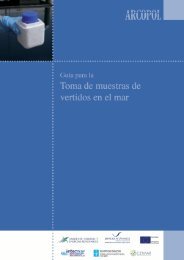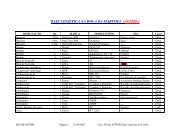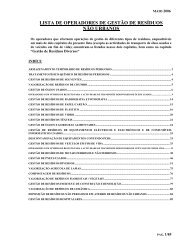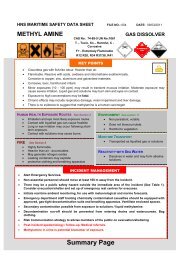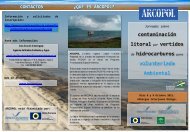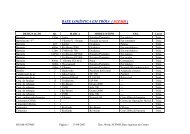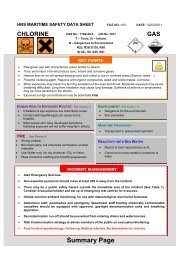ammonia gas (d) - Arcopol.eu
ammonia gas (d) - Arcopol.eu
ammonia gas (d) - Arcopol.eu
Create successful ePaper yourself
Turn your PDF publications into a flip-book with our unique Google optimized e-Paper software.
HNS MARITIME SAFETY DATA SHEET FILE NO.: 003 DATE: 09/03/2011AMMONIACAS No: 7664-41-7 UN No: 1005F- Flammable, T – Toxic, C - Corrosive,N – Dangerous to EnvironmentR10, R23, R34, R50S(1/2), S9, S16, S26, S36/37/39, S45, S61SECTION 5: EXPOSURE CONTROLS / PERSONAL PROTECTIONCONTROLS:- Use fine water spray.GAS (D)- Spillages and decontamination run-off should be prevented from entering sensitive watercourses. Ammonia canbe allowed to enter drains washed with with large quantities of water.PERSONAL PROTECTIVE EQUIPMENTNOTE:Where atmospheric <strong>ammonia</strong> concentrations are unknown or exceed 250 ppm recommend fullencapsulation (<strong>gas</strong>-tight) clothing and SCBA or positive pressure air supply respirator.EMERGENCY ACTION CODEEAC 2RERESPIRATORY PROTECTION Breathing apparatus (BS EN 137)EYE PROTECTIONChemical resistant goggles (BS EN166)SKIN PROTECTION Liquid-tight chemical protective clothing (BS 8428)EMERGENCY RESPONDERSOTHER PROTECTIVE CLOTHINGOR EQUIPMENTAmbulance staff, paramedics and emergency department staff treatingchemically contaminated casualties should be equipped with approved,<strong>gas</strong>-tight decontamination suits based on EN466:1995, EN12941:1998 andprEN943-1:2001, where appropriate with breathing apparatus(BS EN 137).APP A(c) Liquefied <strong>gas</strong> with boiling point below -20 °C.WORK HYGIENIC PRACTICES:Decontamination should be performed using local protocols in designated areas such as a decontaminationcubicle with adequate ventilation.Secondary contamination is possible. Ammonia is highly soluble and can condense on the skin and contaminateothers dermally and by volatilisation, unless protected. Wash skin with soapy water for 10 – 15 minutes.DECONTAMINATION OF RESPONDERS:Decontamination should be performed using local protocols in designated areas such as a decontaminationcubicle with adequate ventilation. Wash skin with water for 10 – 15 minutes.NON ESSENTIAL PERSONNEL / PUBLICThere may be a public safety hazard outside the immediate area of the incident. People should stay indoors withwindows and doors closed, ignition sources should be eliminated and ventilation stopped.Non-essential personnel should move at least 150 m away from the incident.Risk communication via news media as well as internet / telephone advice lines should be initiated to inform localresidents / public based upon forecast data or Table 1 estimates.PAGE 6 OF 11



